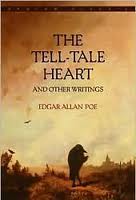 The Tell Tale Heart and Other Writings
The Tell Tale Heart and Other Writings compiles (presumably) Poe’s better short stories and poems. If you’re familiar with “The Raven” and “The Tell Tale Heart” — and anyone who’s taken high school-level English, known a few goths that affect airs, or simply owns a TV would be — you’ll have a good idea of the rest of the book’s material. It also includes Poe’s novella, “The Narrative of Arthur Gordon Pym”, an intricate account of the titular character’s endlessly dangerous voyages at sea.
“Tell Tale”, as a story, is exemplary of Poe’s style because it involves two things: psychosis and the weird uncertainty of death. The narrator kills his elderly roommate because he just didn’t like one of his eyes. Granted, he describes it as milky-white and vulture-like, but the appearance of one’s eye is not a great reason for killing anyone by any means. The narrator, who exhibits an acute sense of hearing at the outset, is driven mad by the beating of the murdered’s heart, which is, incidentally, still beating (even if metaphorically) and is buried somewhere in the floorboards.
In fact, Poe’s laser-like obsession with death, perhaps resulting from his turbulent personal life and mediocre writing career, was a genetic and literary experiment in Hegelian synthesis. His fascination with the morbid caused him to not to necessarily blur the lines between life and death but instead fuse the two until it became a grotesque amalgamation of the two states: not quite an intermediary stage, but an altogether new manner of existence. An animal is symbolically reincarnated (“The Black Cat”), a dead body became reanimated (“The Facts in the Case of M. Valdemar”), a brother and sister that might as well be dead actually died (“The Fall of the House of Usher”), a prisoner narrowly avoided a final death, deus ex machina-style (“The Pit and the Pendulum”), and a hapless sailor who constantly brushes with death kinda-sorta died while sailing to the entrance of the hollow earth (“Pym”).
While the constant plot element of being trapped/buried alive or held in abeyance with the threat of death would be of note to historical psychologists and literary biographers alike, this collection serves as a great introduction into the macabre and Romantic literature.